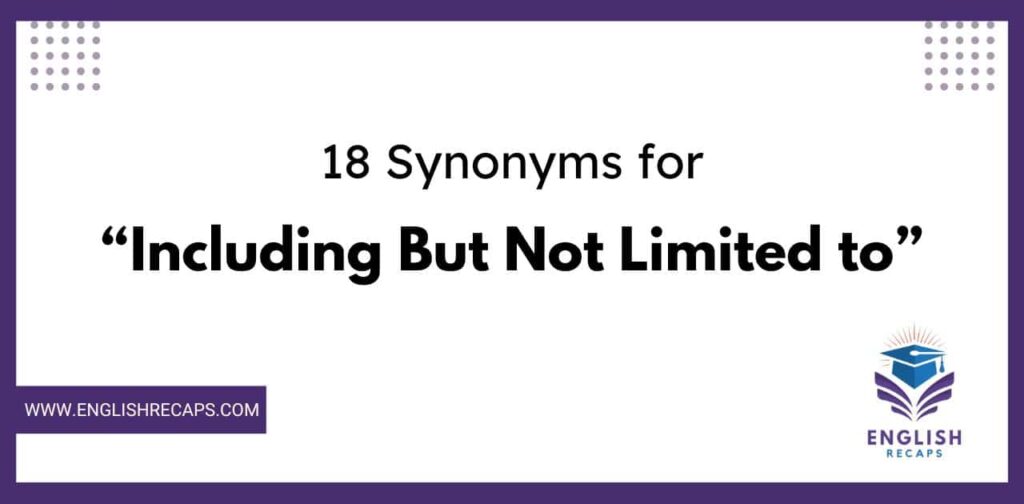18 Creative Alternatives to “Including But Not Limited to” for Varied Writing Tips 2024
The phrase “including but not limited to” is common in legal and business writing to introduce examples, while implying additional unspecified items may apply as well. However, the wordiness tends to sound redundant after too much use.
What are some creative yet clear substitutes you can use instead? This article explores 18 eloquent alternatives to incorporate variety into your professional writing.
Can You Say “Including But Not Limited to”?
You can certainly use the phrase “including but not limited to” in writing. It conveys the essence of providing some specific examples, while indicating there may also be others relevant that you have not spelled out.
However, the inherent redundancy in “including” already implying an open-ended list makes “but not limited to” unnecessary extra verbiage. As such, the phrase risks coming across as wordy instead of precise.
Pros:
- Highlights examples independently from other unspecified variables
- Familiar phrase widely understood
Cons:
- Redundant and wordy
- “Including” works well on its own
Now let’s explore 18 substitute phrases to mix up your business writing style.
18 Creative Alternatives Synonyms for “Including But Not Limited to”
- Including
- Not Forgetting
- Options Include
- The Options Are
- For Instance
- Could Be
- In This Case
- Not Limited To
- Together With
- Embracing a Spectrum: Inclusive Of
- Encompassing Without Bounds: Covering
- All-Encompassing Unity: Comprising
- Unbounded Possibilities: Incorporating
- Emphasizing Inclusivity: Consisting Of
- Allowing Room for Expansion: To Wit
- Embracing the Full Spectrum: Namely
- Diverse Elements in Harmony: Among Other Things
- In the Mix: Entailing
1. Including
Simply using “including” avoids redundancy while listing examples as part of a larger whole. Using merely “including” as opposed to “including but not limited to” stands as an eloquent alternative that avoids wordiness while listing pertinent examples within a broader group. Including functions professionally to highlight select items of relevance without an exhaustive enumeration of every possibility.
For instance:
We will be evaluating several initiatives, including the client reporting portal.
This conveys you will name specific initiatives without an exhaustive list.
To further illustrate application in a business context:
I will elaborate on recent customer service updates momentarily, including the expedited complaint resolution process we tabled in our last meeting.
You may wish to learn another related post: 21 Other Ways to Say “Have a Great Weekend” in an Email
2. Not Forgetting
In a more conversational tone, try “not forgetting” to imply additional relevant items beyond those you list:
As a candidate, I offer many relevant experiences, not forgetting my 3 years of analytics experience.
In addition, the phrase “not forgetting” can also be used effectively in professional profiles and documents like resumes when comprehensively showcasing skills and experiences.
Using “not forgetting” offers a means of incorporating supplemental, relevant capabilities from a wider repertoire while avoiding exhaustive enumeration of each one’s details.
For instance, on a resume, one might state:
I possess demonstrable competencies across an array of methodologies, not forgetting the customized engagement tactics that generated successful outcomes for past clients.
Additionally, as a versatile marketing professional, I offer other strengths beyond core strategic expertise, not forgetting the adaptability enabling me to produce under pressure despite obstacles.
3. Options Include
When presenting a subset of possibilities extracted from a broader list, the phrase “options include” professionally demonstrates sampling without exhaustive enumeration. This aptly serves as a précis for “including but not limited to”.
Specifying select options indicates intent to subsequently analyze those items highlighted from a wider roster. This enables narrowing down decision vectors based on realistic evaluation of best return-on-investment across the calls-to-action under consideration presently.
When presenting choices, substitute “options include” to again avoid suggesting those you name are the only possibilities:
Options include pursuing an income fund or a balanced fund tailored to your goals.
4. The Options Are
Within written arguments or analyses, unambiguously delineating options using the direct statement “the options are” improves clarity for readers versus verbose qualifiers like “including but not limited to.”
Succinctly introducing enumerated considerations enables rapid orientation to pivotal decision factors under examination, sans an exhaustive inventory of peripheral possibilities. Audiences can thus devote attentional faculty to assessing the defined vectors judged as most germane by the author.
Similarly, directly state “the options are” when wanting to offer some examples but not the full gamut:
The options are taking the train, booking a rideshare service, or renting a car.
5. For Instance
Within professional communications, the transitional phrase “for instance” enables providing singular, relevant examples without furnishing an exhaustive inventory. Much like “including”, it succeeds at transmitting key details judiciously, while acknowledging wider permutations at play.
When electing to spotlight one option from a larger set, “for instance” introduces the choice in a focused manner to direct audience attention accordingly. However, stringing together multiple selections diluted the effect by competing for mindshare.
With “for instance”, you provide an example while again signaling other relevant ones may exist:
There are a few approaches we can explore, for instance conducting user interviews first.
6. Could Be
When conversing informally among colleagues, the speculative phrase “could be” allows suggesting possibilities under consideration without assertive certainty or exhaustive enumeration. While the inherent tentativeness risks projecting unconvincing indecision in formal documents, “could be” fits verbal discussions needing flexible ideation.
While less definitive, “could be” similarly indicates you are sharing some options among multiple possibilities:
Could be we lack some internal expertise in this area right now. But there may be other factors at play too.
7. In This Case
When options relate to a specific situation, use “in this case” to offer some suggestions tailored to it:
In this case, we should prioritize apps compatible across mobile and desktop.
8. Not Limited To
If your examples represent only a sample, clarify that with “not limited to” – implying they do not reveal the full scope:
My relevant background is not limited to the positions shown, so please ask if you need to know more.
9. Together With
Likewise, specify you are naming options selectively by saying “together with” before listing a few:
We will evaluate your foundation goals together with your visions for global outreach…
10. Embracing a Spectrum: Inclusive Of
This eloquent substitutewarmly embraces unspecified options beyond those named:
Our daycare nurtures all children, inclusive of those with special needs.
11. Encompassing Without Bounds: Covering
Similarly suggest your open-ended perspective by “encompassing without bounds” the possibilities:
Our counseling services cover struggling students, to name a few groups.
12. All-Encompassing Unity: Comprising
Or emphasize that inclusivity with “all-encompassing unity” that “comprises” some examples without excluding others:
Our diverse leadership team comprises talented minds across technology, marketing, and product.
13. Unbounded Possibilities: Incorporating
The verb “incorporating” also indicates an inclusive mindset – you welcome “unbounded possibilities”:
I pride myself on incorporating diverse views, including those I disagree with, to reach well-rounded decisions.
14. Emphasizing Inclusivity: Consisting Of
Likewise, say you “emphasize inclusivity” by using judgment-free language like “consist of” rather than “includes” or “contains”:
Our programs consist of methods suitable for all learning styles.
15. Allowing Room for Expansion: To Wit
Alternatively, signal openness to additional relevant items with the elegant “to wit”:
We offer several payment options to wit credit card, PayPal, and monthly direct bank withdrawals.
16. Embracing the Full Spectrum: Namely
Classically state your intent to “embrace the full spectrum” of possibilities by saying “namely” before your examples:
As a teacher, I strive to embrace all learning styles, namely visual, auditory, kinesthetic, and more.
17. Diverse Elements in Harmony: Among Other Things
Articulate your inclusive outlook by referring to “diverse elements in harmony among other things”:
Globalism brings many advantages among other things cross-cultural collaboration, improved efficiency, and idea sharing.
18. In the Mix: Entailing
Or use “in the mix” to suggest your examples are “entailed” as part of a bigger picture:
My role entails managing client accounts, for one, to ensure exceptional service delivery.
Don’t miss out read this blog: 15+ Other Ways to Say “I Look Forward to Working With You”
How to Use These Alternatives Effectively
When choosing an alternative to “including but not limited to,” consider:
- The formality of your document
- Your audience’s expectations
- The specific context of your writing
- The need for legal precision versus conversational tone
Common Mistakes to Avoid
- Overusing any single alternative
- Choosing an informal alternative for a formal document
- Using alternatives that don’t clearly convey the open-ended nature of your list when needed
When to Stick with “Including But Not Limited To”
While alternatives can improve your writing, sometimes the original phrase is still best, particularly in:
- Legal documents requiring utmost clarity
- Formal contracts where precision is crucial
- Situations where the phrase is an expected industry standard
Conclusion 18 Synonyms for “Including But Not Limited to”
Rather than sound restrictive using “including but not limited to”, adopt one of these creative alternatives. Flowery language like “inclusive of” or “among other things” makes your writing more engaging while still communicating open-ended inclusion.
With options spanning classic simplicity like “namely” to rhetorical flair like “diverse elements in harmony”, you can avoid redundancy. Instead choose dynamic substitutes that keep readers receptive.
While your examples provide key specifics, embracing a bigger picture perspective ultimately makes your writing more powerful. So expand beyond “including but not limited to” for eloquently inclusive communication.


